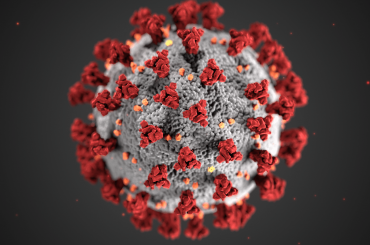This flight test of the Cessna Citation CJ3+ by Owen Zupp first appeared in the May 2019 edition of Australian Aviation.
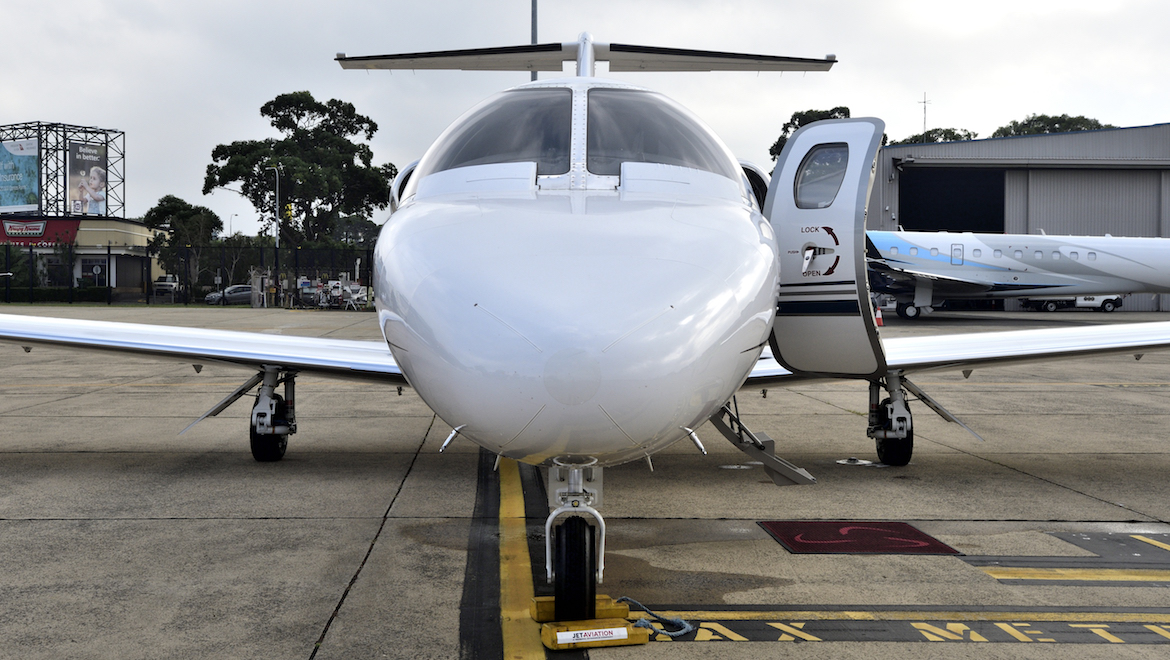
The Citation range has come a long way in the 50 years that Cessna has been in the business of business jets. Today, Textron Aviation, continues to refine its substantial fleet to deliver flexibility from the entry level Citation M2 right through to the Mach 0.935 Citation X+. In keeping with that tradition, the Citation CJ3+ continues to offer something more.
Stepping up
In designing the Citation CJ3+, Cessna has not sought to reinvent the wheel. In many ways, it is an extension of the Citation M2, offering the ability to fly two more people higher, farther, and faster without sacrificing any of the impressive takeoff and landing distance performance. And just as the Citation M2 can be flown single-pilot under instrument conditions by a suitably trained and qualified private pilot, so too can the CJ3+.
While the performance envelope has been subtly grown from the M2, the CJ3+ has a noticeable change in its external appearance as it sits on the tarmac outside the recently renamed Jet Aviation facility at Sydney Airport. Its lines are longer, accentuated by seven windows along its fuselage rather than four. Dimensionally, the CJ3+ is more than two metres longer at 15.59m. Another differentiating feature from its smaller sibling is the absence of any winglets, with the wing tapering to a flush tip. Common are the attractive T-tail with its swept fin, aft-mounted engines and the relatively straight wing – almost a trademark for this chapter of the Citation range. Among the array of business jets on show at Sydney’s business jet parking area, the Citation CJ3+ fits right in.
US-based Textron Aviation demonstration pilots, Jim Neely and Tim Baca have recently joined the CJ3+ tour in New Zealand, having flown into Sydney the day before. It is a tour that will see them head northward in Australia and stopping in Singapore and China, before wending their way to South Africa. There, they will hand over the demonstration tour to another crew and return home.
Our flight today will be much shorter. With southern departures operating at Kingsford Smith Airport, we will head out via Wollongong before making our way towards Canberra and ultimately returning from the west. Even for such a brief flight, Flight level 380 is a comfortable level to see the CJ3+ at work, affording more than adequate time in the cruise.
Still, before we take to the skies, we need to take a closer look at this nine-seat business jet.
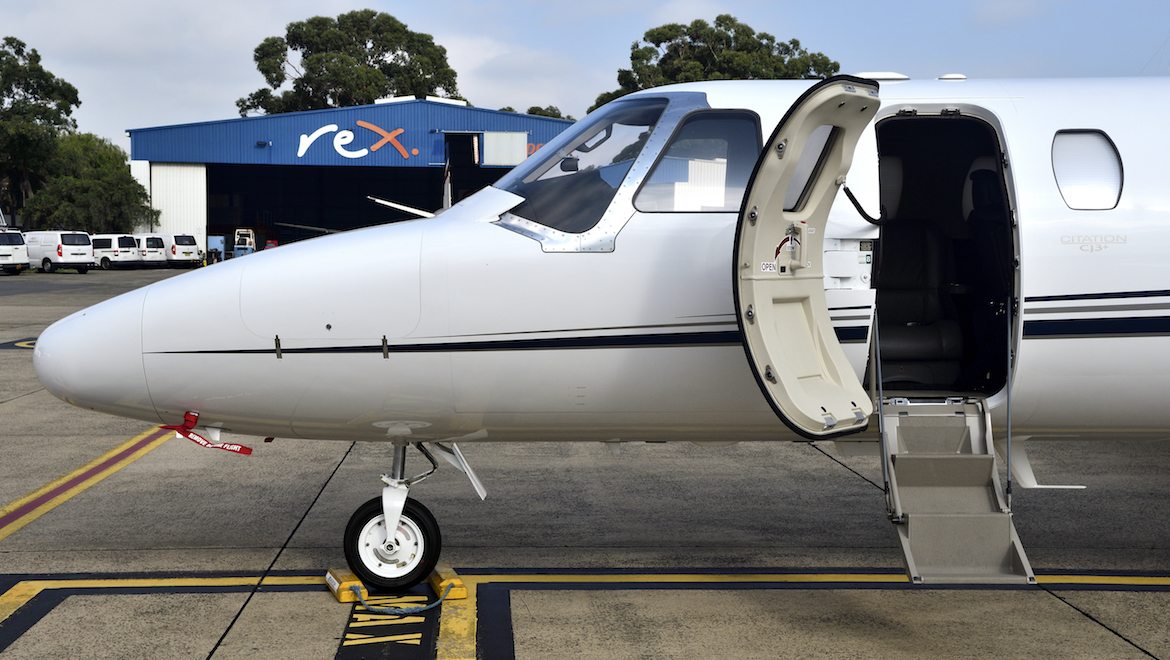
Up close
In keeping with the Citation range, the fold-down air-stair is located aft of the cockpit and ahead of the left wing and features a double-seal door. Moving forward, the nose compartment is accessible from both sides, through two top-hinged locker doors. On the aft wall, the panel has a series of windows for the easy inspection of gauges relaying the status and quantities of various systems such as oxygen, landing gear and brakes. Externally, the nose section is host to an array of aerials and sensors, including one for the Angle-of-Attack, and a conventional nose wheel.
The wing span of the CJ3+ is 16.26m with the leading edges heated for anti-icing and a small ‘aileron fence’ rises from the upper surface, just inboard of the ailerons. With filler caps on the outboard section, each wing houses a single fuel tank for a total useable capacity of 2,661 litres. By virtue of the wing design, the CJ3+ has retained almost identical takeoff and landing performance to the M2 allowing it to takeoff in under 1,000m and land in less than 800m. However, the ceiling of the CJ3+ is 4,000ft higher at 45,000ft and faster with a maximum speed cruise speed of 416kts true airspeed.
Inboard of mid-span, on the upper and lower surface are speedbrake panels. The top panel is solid, while the lower panel is perforated and the speedbrake can be deployed in flight, on the ground or in association with selecting ‘ground flap’. The flaps are traditional Fowler flaps on the wings’ trailing edge and can be selected to 15 degrees for takeoff, or 35 degrees for landing. Ground flap extends the flaps to 55 degrees, rather than the M2’s 60 degrees, and in association with speedbrake deployment on landing, contribute to the impressive landing performance. While the primary flight controls are mechanical, the gear, flaps and speed brakes are hydraulically-actuated.
Where the wings meet the fuselage, the modern Citations have a “large aeroplane” look, while serving a somewhat concealed purpose. The faired section provides a straightforward path for systems, cables and hoses to run along the aircraft without interfering with the pressure cell that constitutes the cabin. Also, this design allows a shallow drop in the centre wing section that permits attachment of the wings to the fuselage without interruption of the cabin’s cross-section and even allows a slightly lowered aisle for added headroom.
The main landing gear has a trailing arm linkage, which makes for flattering touchdowns for pilots and comfort for the passengers in the cabin. Hydraulically-operated in normal operations, the gear can be allowed to free-fall or be ‘blown down’ in an emergency. Brake wear indicators are just as you find on airliners, and the cue to replace the brakes is when the protruding inductors sit flush with the rest of the brake assembly.
The T-Tail stands tall at 4.62m and two Williams International FJ44-3A engines are mounted on the aft fuselage, with each producing 2,820lb of thrust. The engines incorporate dual channel full authority digital engine controls (FADEC) to provide both automation and efficiency in engine management. Mounted behind the passenger cabin these medium-bypass engines minimise cabin noise both through their design and location.
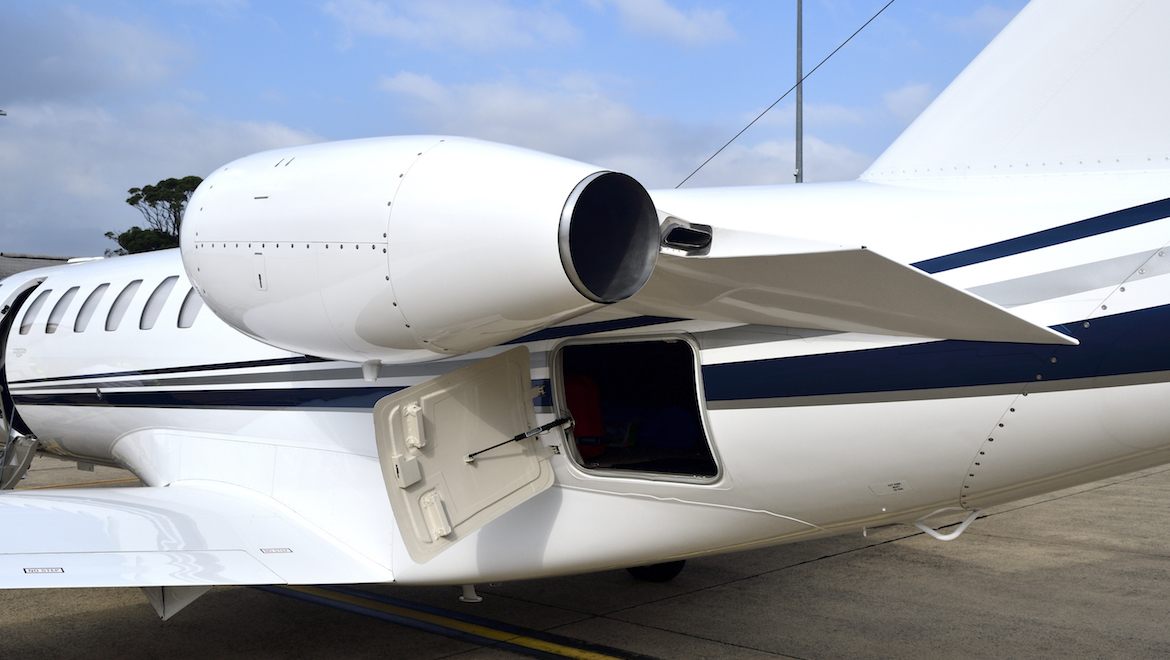
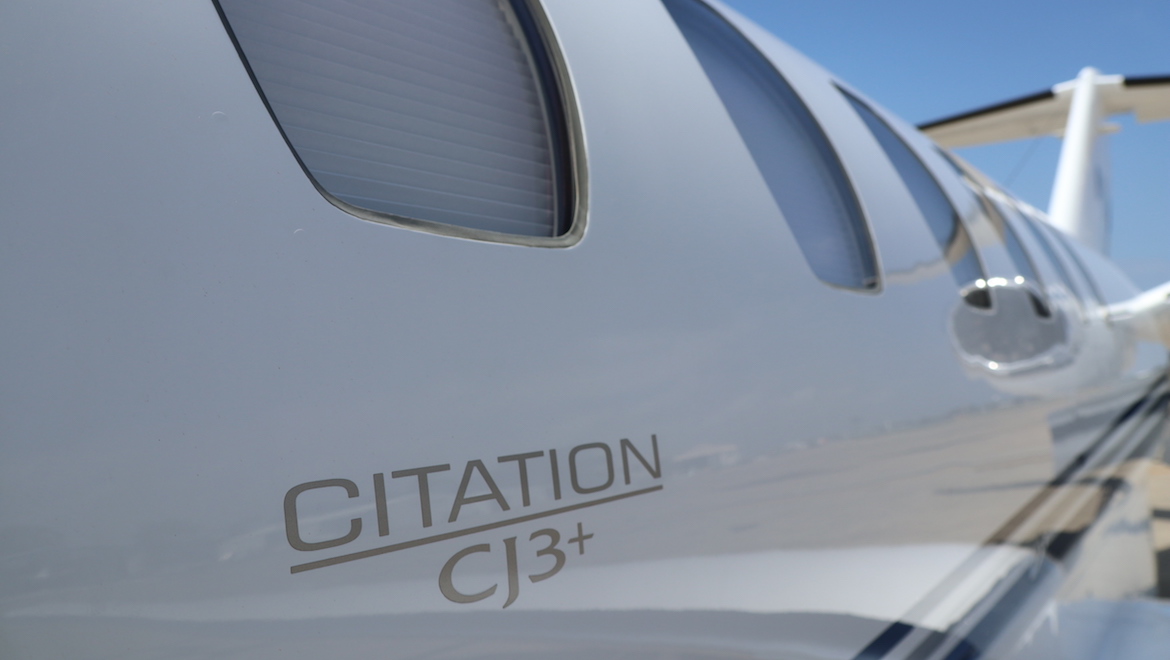
On the inside
One never tires of stepping into a business jet and having done so several times in the Citation range, it never fails to impress. Generous windows, a slightly sunken aisle, smart selection of décor and a high-class finish give an air of comfort and space. As always, the high-backed leather seats can be configured in a variety of arrangements, including club seating. Along with sizeable fold-out tables and various connectivity options, the cabin makes for an ideal workplace or dining area depending on the task at hand.
With full fuel, the CJ3+ has 820lb of payload. A more useful figure is that with a pilot and four passengers it possesses a range of just over 1,800nm, which is again a step up on the M2’s range. Should the need arise to fill all of the seats and carry eight passengers, the range is 1,356nm.
As impressive as the passenger cabin may be, for pilots the cockpit is every bit as luxurious in both appointments and equipment. New avionics lend themselves to offering a flight panel with an uncluttered look and the Garmin G3000 system which hosts three large LCD screens and two small central Garmin Touch Screen Controllers (GTC) is no exception. A clean centre panel with small, sporty thrust levers are in good company with the sporty control yokes. The seats are easily adjustable in all directions and the windscreen affords a sensational view to the front and sides. There’s even an additional push-to-talk switch near the outboard arm rest which is very handy.
Personally, it can be quite some time between flights with a Garmin system, but the simple, intuitive nature is highlighted by the speed with which the system once again becomes relatively familiar. It is logical and easy to step through and in the event of a data entry error, easy to backtrack and correct.
With minimal guidance from Jim, I am able to program performance data, the flight plan and all the required elements through the Garmin GTCs. Tim is our only passenger, so once the latest ATIS has been copied, the simple single-pilot checklists completed and the doors closed, we are ready to start the engines and take flight.
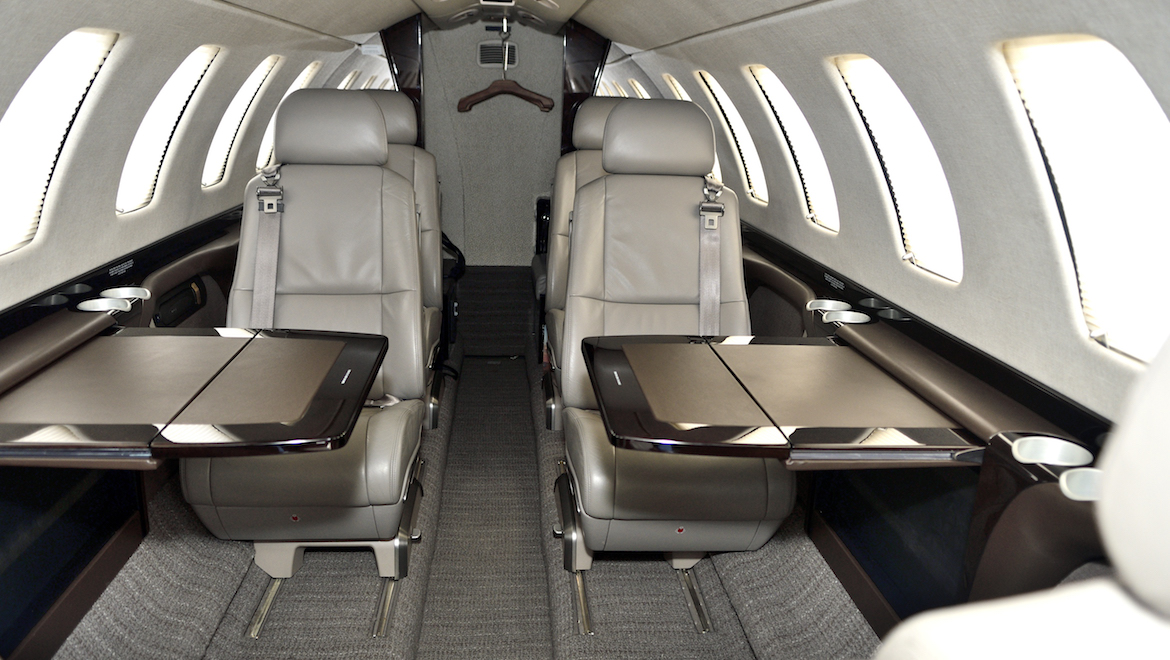
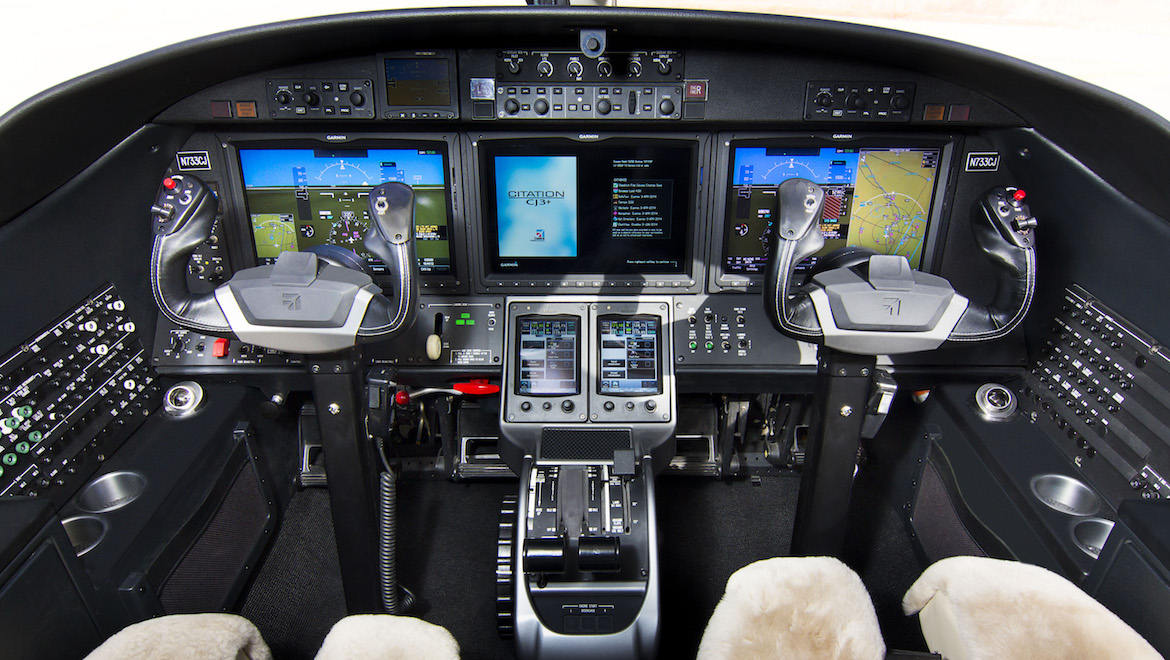
Up and away
Every time I start the FADEC-controlled engines of a Citation, I am impressed by the simplicity of the process. A push-button starter switch is depressed, initiating the sequence and when achieving the required N2, the thrust lever is moved forward to the idle setting to introduce fuel and the engine ‘lights off’. The starter cuts out automatically and the whole sequence is displayed clearly on the Garmin engine instrumentation. Guarding against hot and hung starts is still the pilot’s responsibility but otherwise the process is fundamentally automatic.
Engines running, taxi clearance received, and parking brake released, we are quickly underway with a brake and yaw damper check conducted from either side of the cockpit. Only small inputs of thrust, brake or rudder are needed to manoeuvre the CJ3+ on the ground and the controls are both light and responsive. The pre-takeoff sequences are minimal as one would expect for a single-pilot certified aircraft and with very little time lapsed we are at Sydney’s Runway 16 Left and ready for takeoff. Our takeoff speeds today with three on board are V1 99kts, rotate at 105kts and V2 of 110kts.
For takeoff, the thrust levers will need to pass through a series of detents as they are moved forward from idle, through ‘cruise’ and ‘climb’ to ‘takeoff’ – three ‘clicks’. Lining up, the aircraft is easily turned through its small radius to come to rest on the centerline. Once a Dash-8 has cleared the runway, our takeoff clearance is forthcoming
The thrust levers are advanced through the clicks and the Garmin panel confirms that the engines are performing as expected. The speed tape races down the main flight display and we accelerate to our takeoff speeds in quick time. Rotating the aircraft to 10 degrees body angle we are climbing away with impressive performance. Landing gear retracted, there is no need for a level segment to accelerate; we just continue to climb and retract the flaps on schedule.
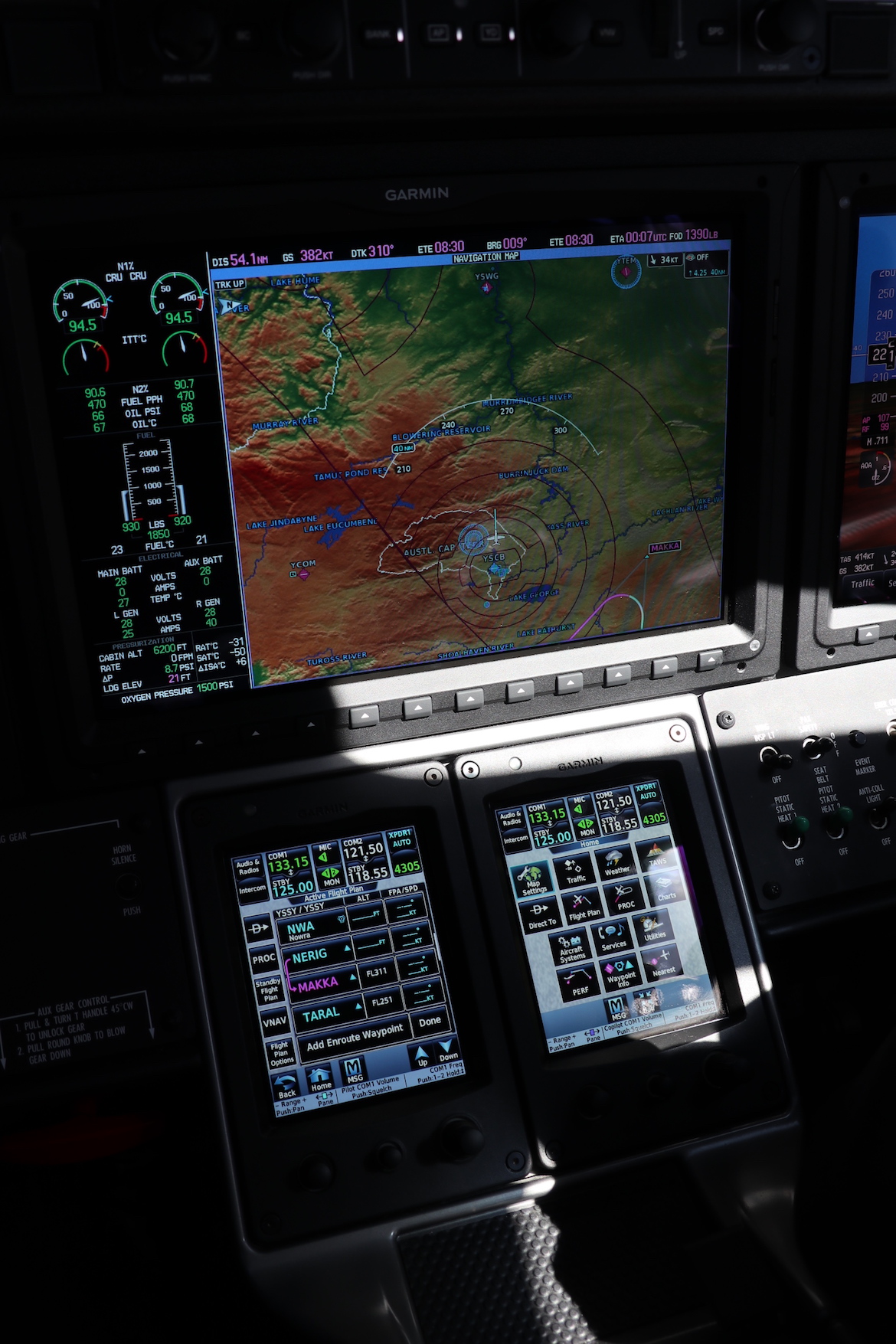
Weather is passing through Sydney in the form of a low unstable layer so I keep the speed back and after a few bumps we spear up into the smooth, clear skies above. We turn towards Wollongong and passing 10,000ft I apply Jim’s ‘rule of thumb’ for the body angle: “10 degrees to 10,000ft and 5 degrees beyond that”. Obviously, there is fine tuning to be applied, but the adjustment works well, and we accelerate further and continue our climb to the flight levels.
To facilitate our flight and our slot time, Sydney Air Traffic Control kindly offers us a series of vectors which allow me a chance to feel the CJ3+ as it changes course a number of times. The aircraft is stable and offers a comfortable ride as it sweeps through the sky. Undoubtedly the passengers will enjoy flying in this aircraft, but equally pilots will love it. Passing FL280 I reluctantly engage the autopilot to enter some data into the GTCs and sit back to monitor the remaining climb to FL380.
Leveling off after about 17 minutes, the aircraft accelerates before I bring the thrust levers back to settle at 220kts IAS, or Mach 0.707. At this speed we have 94 per cent N1 set and are burning a miserly 470 pounds/hour per side. For the cabin, the interior altitude is only 6,200ft. At this speed there is still 10kts margin to the limiting ‘barber’s pole’ but I conservatively opt for a little margin as I take my time to brief and plan the return to Sydney.
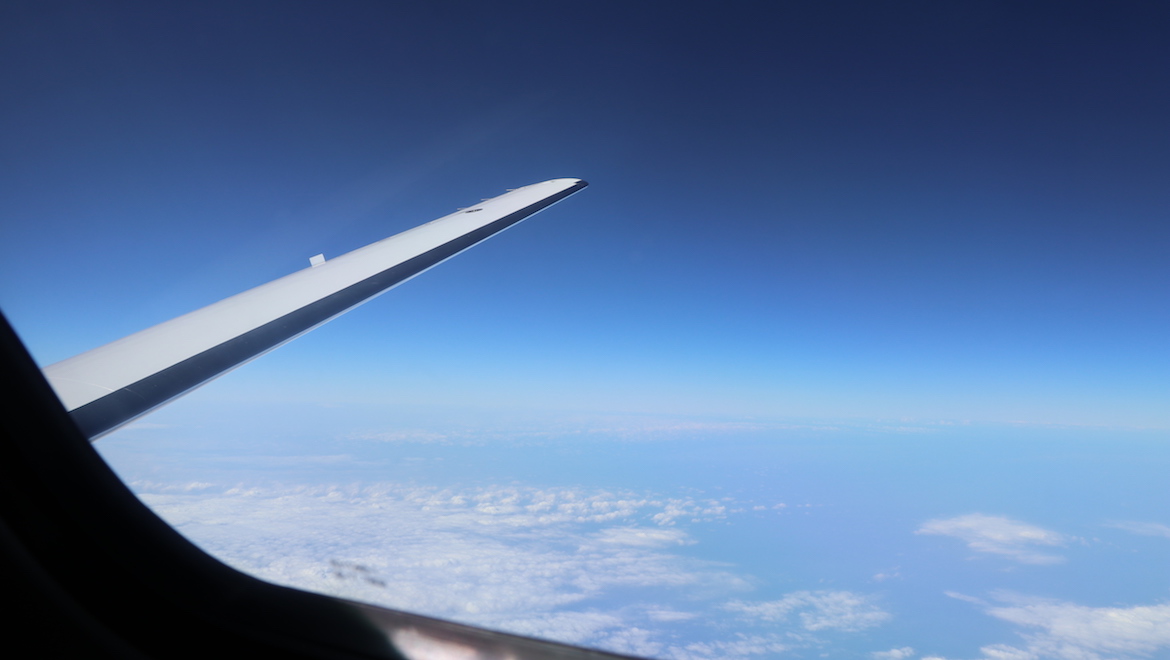
ATC clears us for descent and a Rivet arrival for Runway 16 Right, while issuing crossing times on top of the altitude restrictions. Other than the time, I program these restrictions, although it is up to the pilot to manage them. There is no autothrottle, or autothrust for Airbus folks, so as top of descent approaches, I manually retard the thrust levers to idle. A vertical scale indicates our vertical path and a line of progress information indicates the current time at the nominated waypoint. Through subtle changes in speed and profile, the requirements are easily met without level segments and spooling up engines to disturb potential travellers in the cabin.
Through “Transition” and closing in on Sydney, I reduce the rate of descent, opting for the Vertical Speed mode before a right turn sends us to the north. Further speed reductions are issued and a small reduction in thrust has the speed winding back before power is reinstated. Throughout the descent, the speedbrake was not needed as the aircraft allowed easy transitions to faster and slower flight and changes to descent profile. Still, if needed, the speedbrake was there.
Granted a heading change to avoid a build-up of cumulus that was still loitering in the area, we are shortly given further vectors to the east to join the ILS for 16 Right. This time, when a speed increase was requested, the CJ3+ did so with ease and a minimum of effort. The autopilot smoothly intercepted the localiser but as we came onto glideslope, it was time to fly again.
Disconnecting the autopilot also disconnected the yaw damper, so I re-engaged it for the approach. One can also “tap” or engage the electric trim to disconnect the autopilot while retaining the yaw damper. Comfortably below 200kts I select the gear down and 15 degrees of flap. Having met the speed requirement from ATC I slow below 160kts and select the final stage of flap at 35 degrees. The pitch changes are minimal, and the aircraft sits steadily on the approach path with no need for additional trim.
Vref for the landing is 102kts with an approach speed of 110kts, with Jim suggesting an initial target speed of 120kts, bleeding the excess off in the latter stages of the approach. It all seems very similar to the M2 and only minor movements of the thrust levers are needed to change the speed by a knot or two.
As the runway looms closer, I disengage the yaw damper. The speed is washed off gradually and with a few extra knots of energy remaining, the thrust levers are closed just prior to entering the flare. Jim had mentioned that carrying thrust into the flare will only serve to keep this jet flying.
The trailing arm undercarriage ensures a smooth touchdown and the nose is lowered onto the runway. Without delay I move my hand to the flap lever and this time I raise it, moving it aft to the 55-degree, ground flap setting which also deploys the speedbrake. The aircraft is not equipped with reverse thrust but the combined effectiveness of the wheel brakes, ground idle and speedbrake would suggest that it’s not needed.
We turn to taxi via Sydney’s cross runway and complete our checks. Exiting toward the parking apron we manoeuvre with ease and a wealth of wingtip clearance in a relatively confined area. Moving the thrust levers aft of the idle position I shut the engines down. Chocks are in and our flight has come to an end.
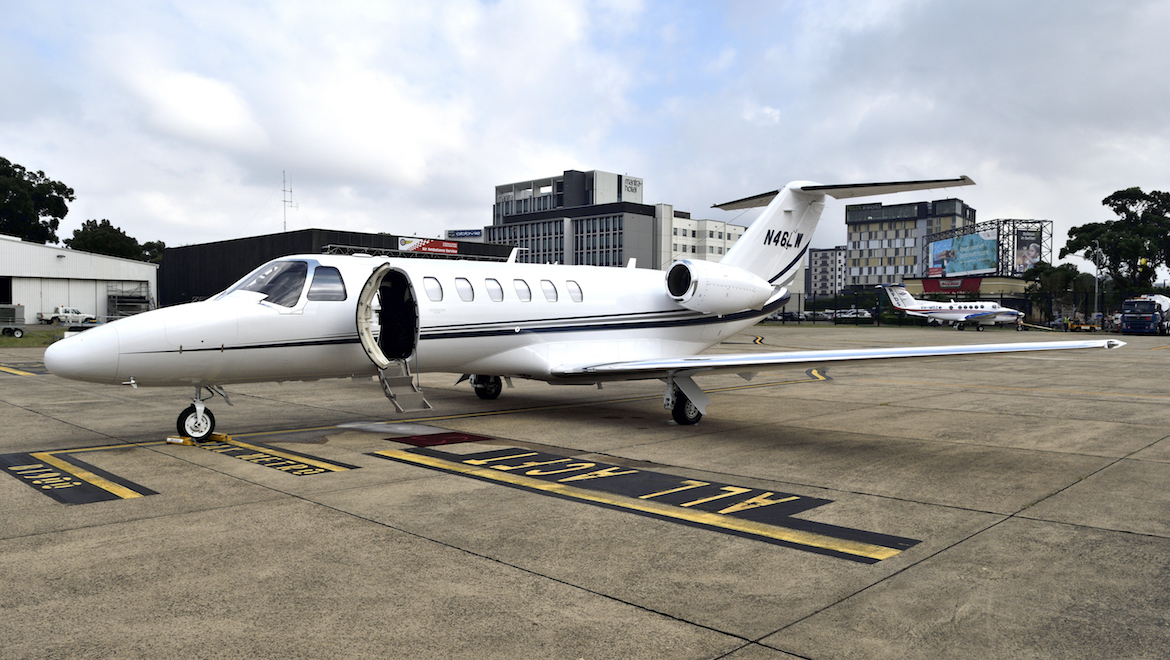
Stepping up
The similarities between the Citation M2 and the CJ3+ are undeniable – and that’s a good thing, just as the M2 is a wonderful entry level business jet, offering enough increased performance to add a degree of flexibility to its operational envelope in terms of passengers, speed, altitude and range.
Single-pilot instrument flight operations are challenging but through design, the CJ3+ offers an aircraft with systems, ergonomics and checklists that offer the pilot every assistance.
In doing so, moving onto the Citation CJ3+ is not a giant leap. It is more a case of stepping up.
This story first appeared in the May 2019 edition of Australian Aviation. To read more stories like this, become a member here.

